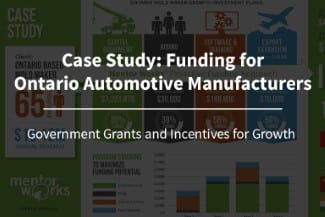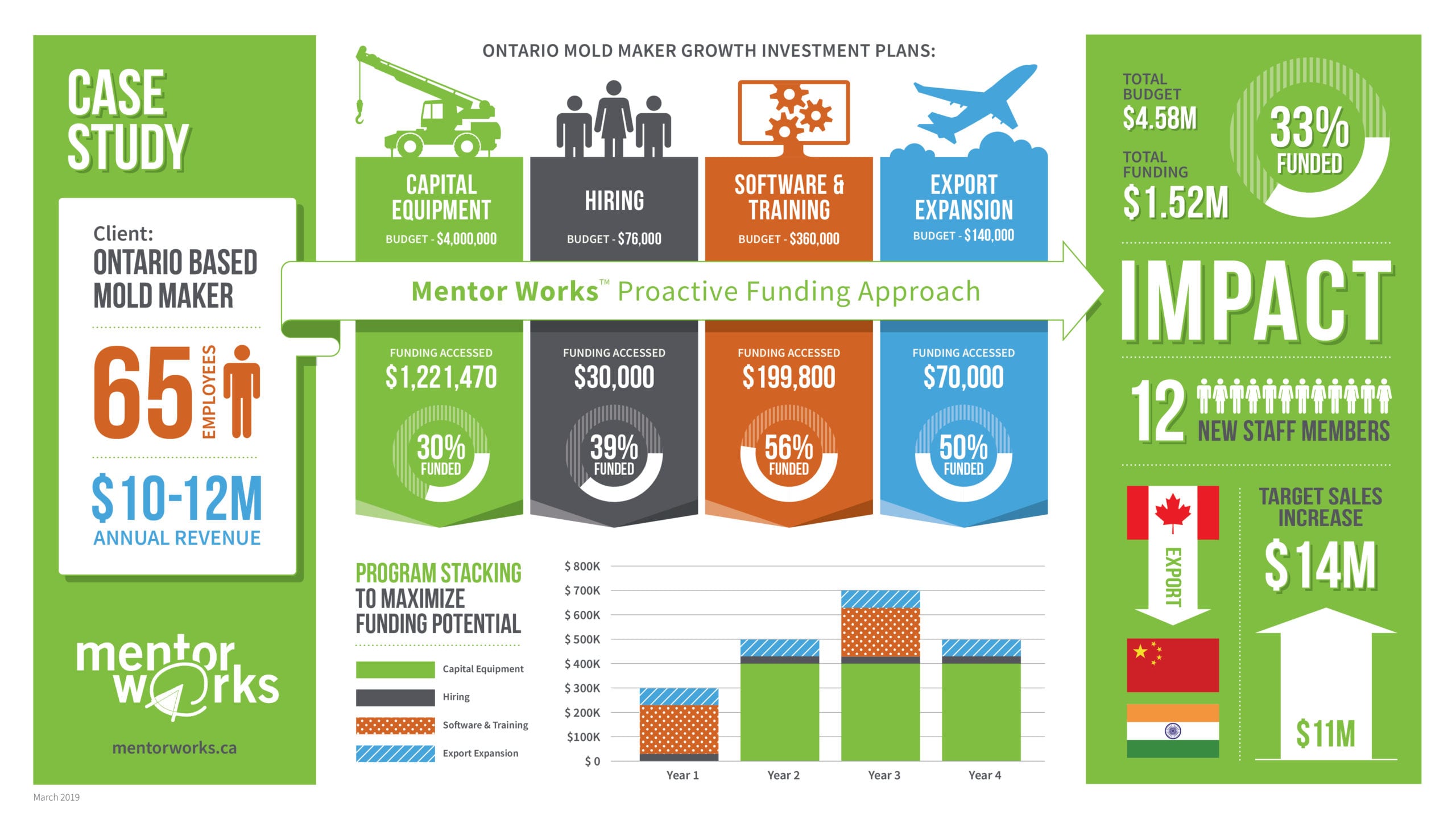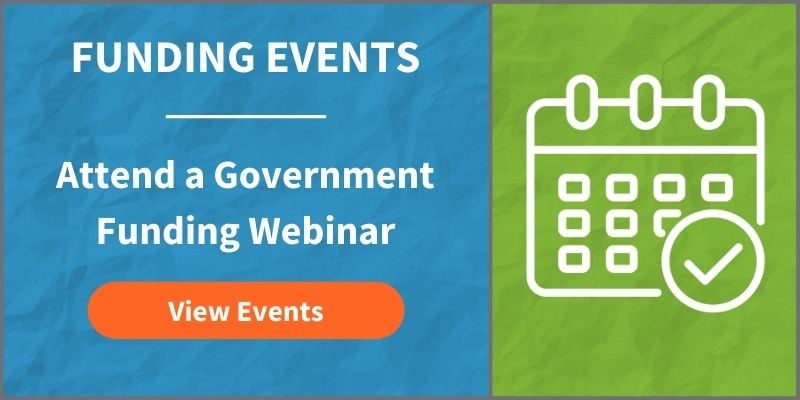Case Study: How Automotive Grants Help Overcome Growth Challenges

Canadian automotive manufacturers can accelerate growth by integrating their strategic activities with government funding, but how exactly does it work? How do other automotive manufacturers use government grants and loans to enhance investments and drive organizational success? It can be difficult to visualize the impact of developing and executing a multi-program government funding plan, especially when used over several years and multiple projects, but the results are profound. Without a doubt, the time and resources required to access government funding programs are worth it.
Developing and using government funding strategies can help your business overcome common growth challenges and enhance its global competitiveness.
Manufacturers can use government funding for a wide variety of strategic investments, including to align themselves to Industry 4.0 standards, empower employee decision-making with data analysis, master automation through efficiency and modernization, become more “green”, and eliminate waste from operations. Strategic-minded automotive manufacturers take a calculated approach to overcome these challenges with the help of Canadian government funding programs, and your business should consider tapping into similar incentives. In this article, we’ll illustrate the benefits of accessing government grants and loans while helping you uncover some of the top supports.
Ontario Mold Maker Grows with Government Funding
In Ontario there are many strategic, forward-thinking automotive businesses that are well-aligned for government funding success. One such automotive mold maker embedded funding into several investments aimed at improving productivity, innovation, and exports while also expanding their workforce. We’ve outlined their success through our Case Study: Ontario Based Mold Maker infographic.
The mold maker commenced their increased focus on funding with 65 employees and approximately $10-12 million in annual revenues. They already exported to the United States but identified other global markets like India and China that would help diversify their customer network. To achieve the growth rate they wanted, they planned to make several key investments in equipment and workforce development over the next few years.
From this starting point, we worked with the mold maker to develop a government funding plan that took a phased approach to matching company spends with active funding programs. The result was an actionable guideline for applying to government funding that helped the company better manage cashflows and improve project return-on-investment (ROI).
Government funding programs helped the automotive manufacturer access over $1.52 million, reduce project costs by 33%, and increase sales revenue by $3 million over the course of the project.
To achieve this level of government funding success, companies should explore four areas of government funding support, including capital equipment, hiring, software and training, and export expansion. Want to develop a government funding plan around these areas? Consider how your business could use government funding programs to enable growth through:
Capital Equipment
The first and most pressing goal for the mold maker identified in our case study was to drive commercialization through the integration of new capital equipment such as a crane, lathe, gun drill, waterjet, and material handling cranes. Investing in this equipment would help them achieve full vertical integration and offer new capabilities that would expand sales across North America. By using Mentor Works to develop a government funding plan, the mold maker learned about two government funding programs that could offset project costs:
- Provincial CapEx Funding: Provides up to 10% of eligible project expenses to a maximum $1.5 million in Ontario government grants. Program focuses on large-scale expansion projects and job creation.
- Federal CapEx Funding: Provides up to 35% of eligible project expenses to a maximum $10 million in repayable funding contributions (e. five-year term loan program at 0% interest). Program focuses on technology adoption or adaptation projects.
After successfully funding proposals through both programs (leveraging $495,000 and $1,100,000 respectively), the mold maker implemented all the advanced technologies and committed to hiring an additional 12 full-time permanent employees. This uptake in automation, coupled with hiring new employees, led to a powerful transformation where production is more efficient and human resources are committed to value-adding activities.
Hiring Employees
As a spin-off benefit of investing in automated processes, the company needed more employees to support software deployment and new manufacturing capabilities. Fortunately, many of the positions could be filled by students and recent graduates, two areas where government funding can support businesses:
- Hiring Recent Post-Secondary Graduates: Provides up to 50% of the new hire’s wage to a maximum $15,000 during the first 12 months of their employment.
- Hiring Post-Secondary Student Interns: Provides up to 50-70% of the new hire’s wage to a maximum $5,000-$7,000 during their temporary 16- to 18-week employment.
Hiring current students and recent graduates enabled the mold maker to leverage $59,000, including $45,000 ($15,000 x 3) for recent graduates and $14,000 ($7,000 x 2) for co-op interns. These employees directly supported the integration of advanced manufacturing software and, as a result, increased labour productivity.
Software and Training
While adopting new equipment and onboarding new employees was beneficial, a significant advantage from the business’ funding plan came through implementing enterprise resource planning (ERP) software and training employees on how to use it effectively. Connecting equipment and other manufacturing processes through data management software can provide substantial positive impacts on a business’ productivity and decision-making abilities, which is why it’s well-positioned to access government funding programs, such as:
- Software Funding: Provides up to 50% of eligible project expenses to a maximum $100,000 in automotive grants. Program focuses on the purchase and customization of ERP and supply chain management (SCM) software.
- Internal Training: Provides up to 25-50% of eligible project expenses to a maximum $100,000 in training grants. Program focuses on internal managers and/or supervisors to lead employees through a structured training program that directly builds manufacturing skillsets.
- Third-Party Training: Provides up to 50-83% of eligible project expenses and focuses on hiring third-party trainers to administer structured training programs. Training can focus on a broad range of skills development topics, including marketing and sales training or production-oriented training.
A key to this phase of the project was the ability to stack multiple funding programs together. Stacking (theory expanded later in article) is a government funding strategy that enables companies to leverage multiple government funding programs for the same project. The mold maker in this case study purchased an ERP system and design software using government funding, then stacked two other training programs to support ERP implementation. They accessed the full $100,000 in grants available for the ERP system, then received another $110,000 ($50k for internal training, $60,000 for third-party training) for a total $210,000 in Canadian government grants.
Export Expansion
With the right equipment, human resources, and data management systems in place, the automotive manufacturer began to focus on attracting new international customers. Taking a regionalized approach to exporting, company leaders understood that its main growth markets included India and China. Attending trade shows and meeting with key contacts to establish partnerships were their primary market entry strategies, which are project types eligible for Canadian government funding support.
- Trade Show Attendance: Provides up to 50% of eligible project expenses to a maximum $50,000 per application; can submit up to two applications per year to a maximum $99,999 in export grants. This supports participation in trade shows and trade missions where there are opportunities to meet with prospective customers.
- Establishing Regional Partnerships: Provides up to 75% of the eligible expenses up to a maximum $75,000 per application. Program focuses on pursuing collaborative partnership opportunities in other countries; must have initiated discussions with potential partner but not reached formal agreement. Funding offsets the costs associated with travel and establishing a formal partnership.
The mold maker accessed $70,000 through these two programs, $30,000 and $40,000 respectively. Through their export strategy and access to Canadian government funding programs, the company expects export sales to grow to $1 million over the next five years and will continue penetrating the Asian market.
Stacking Government Funding Programs to Maximize Potential
One of the top benefits of working with a Government Funding Planner™ is better visibility of multiple government funding programs that can support your project. Using two or more government grants and loans for the same project, also known as “stacking,” can amplify the impact of funding and help your business drastically reduce the share of project costs it must contribute.
Businesses that lack a comprehensive understanding of the government funding landscape may not apply for multiple programs concurrently and miss funding opportunities.
Consulting Mentor Works is a great first step to realizing your full government funding potential. Like the mold maker in this success story, we’ll help you to understand how funding can support your strategic priorities over the next 12-24 months, develop a unique government funding plan based on these projects, and assist your business throughout the process of getting funded. We’re with you every step of the way to improve your experience and optimize your financial return from government funding.
Discover Government Funding to Support Automotive Growth Projects
Ready to learn more about specific government funding programs your business can use? Mentor Works participates in multiple webinars and live events each month to connect with business leaders. During these sessions, we’ll take a deep-dive into currently available grants and loans, and help you better understand the government funding landscape. We’ll also share how clients work with us, and how to get the process started.


